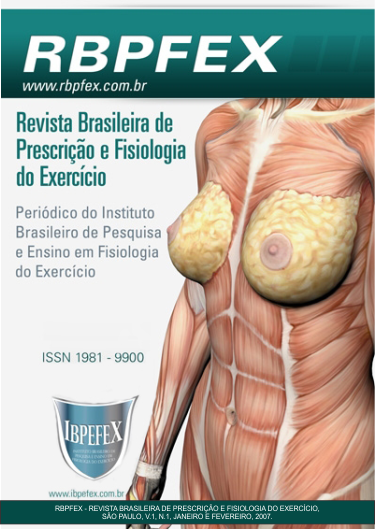Relation between body fat mass and maximum oxygen uptake in the stablisment of risk for cardiovascular disease in policemen from Aracaju, SE
Abstract
This study it had for objective to verify association of the percentage of body fat and the maximum VO2 in the estimate of factors of risks of cardiovascular illnesses in military policemen. The sample was composed for 130 military policemen, with average age of 32.08 ± 4.86, selected from a Battalion of the military policy of the Aracaju city. Were measured body mass (kg), stature (cm) (for body mass index), skin folds, the relation waist/hip, waist’ circumference and percentage of body fat. Cardiorespiratory capacity also was evaluated by means of maximum prediction VO2(ml/kg/min) defined from the Progressive Aerobic Cardio respiratory Endurance Run Test (PACER). The VO2max and the percentage of body fat had been applied to reference values, the criteria from the normative analysis of the percentile. For the analysis of data it was used association qui-square with level of significance of 5%. The group presented normal indexes of body composition, but increased percentage of body fat. In the analysis for criterion, for the studied group, 50% of the military policemen presented risk when analyzed the percentage of body fat. Thirty four percent of policemen presented inadequate levels of maximum VO2. The variable of the percentage of fat and the maximum VO2 meet associates (P≤0.05), for the test of the Qui-square.The results of the present study demonstrated a significant association between body fat and cardiorespiratory capacity.
References
ACSM – American college of sports medicine. Manual para teste de esforço e prescrição de exercício. 5 ed. Rio de Janeiro: Revinter, 2000.
Astrand, Per-Olof e Rodahl, Kaare. Tratado de fisiologia do exercício. Rio de Janeiro: Sedegra S. A. gráficos e editores, 1983.
Barbetta, Pedro Alberto. Estatística aplicada às ciências sociais. 4 ed. Florianópolis: Ed da UFSC, 2001.
Bouchard, Claude. Atividade física e obesidade. São Paulo: Manole, 2003.
Blair, S.N.; e colaboradores. Changes in Physical Fitness and All Cause Mortality. Journal of the American Medical Associaton. 273(14): 1093-1098, 1995.
Blair, Steven N. e colaboradores. Physical activity, nutricion and chronic disease. Medicine science sports and exercise, v. 28, n. 3, p. 335-349, 1996.
Carpenter, Carlos Sandro. Treinamento cardiorrespiratório. Rio de Janeiro: Sprint, 2002.
Coyle, Edward F. Metabolismo lipídico durante o exercício. Sports science Exchange, n. 15, jan-feve, 1997.
Domingos-Benício, Nilsa C. e colaboradores. Medidas espirométricas em pessoas eutróficas e obesas na posição ortostática, sentada e deitada. Revista associação médica brasileira, v. 50, n. 2, p. 142-147, 2004.
Duarte, M.F. da Silva e Duarte, CR. Validade do teste aeróbico de corrida de vai-e-vem de 20 metros. Revista Brasileira Ciência e Movimento. V. 9, nº 3. p. 07-14. Julho, 2001.
Hespanha, Raimundo. Medida e avaliação para a saúde e o esporte. Rio de Janeiro: Rubio, 2004.
Leite, Paulo Fernando. Fisiologia do exercício, ergometria e condicionamento físico. 2 ed. Rio de Janeiro: Atheneu, 1986.
Lima Silva, Adriano E. Ajustes lineares e quadráticos da curva de consumo de oxigênio em teste progressivo. Revista brasileira de ciência e movimento, v. 11, n. 4, p. 13-18, 2003.
Lima, Willian A. Glanner, Maria F. Principais fatores de riscos relacionados às doenças cardiovasculares. Artigo de revisão. Revista brasileira de cineantropometria e desempenho humano. V.8. n.1. p. 96-104, 2006.
McArdle, D.L.; Katch, F.I.; E Katch, V.L. Fisiologia do exercício, energia, nutrição e desempenho humano. 3 ed Rio de Janeiro: Guanabara Koogan, 1992.
Nieman, D.C. Exercício e Saúde: Como se prevenir de doenças usando o Exercício como seu medicamento. São Paulo: Manole, 1999.
Petroski, Édio Luis. Antropometria: Técnicas e padronizações. 2º ed. Porto Alegre: E. L. Petroski, 2003.
Pollock, Michel, L. Wilmore, Jack, H. Exercícios na saúde e na doença: Avaliação e prescrição para prevenção e reabilitação. 2º ed. Rio de Janeiro: Medsi, 1993.
Powers, Scoot, K. e Howeley, Edward T. Fisiologia do exercício: teoria e aplicação ao condicionamento e ao desempenho. 3 ed. São Paulo: Manole, 2000.
Rudio, Franz Victor. Introdução ao projeto de pesquisa científica. 25ªed. Petrópolis: Vozes, 1999.
Rigatto, Alessandra. M. e colaboradores. Performance ventilatória na obesidade. Revista saúde, Piracicaba, v. 7, n. 17, p. 57-65, 2005.
Sharkey, Brian J. Condicionamento físico e saúde. 4ª ed. Porto Alegre: ArtMed, 1998.
Thomas, Jerry R. e Nelson, Jack K. Métodos de pesquisa em atividade física. 3 ed. Porto Alegre: Artmed, 2002.
Thieman, F.G. Perfil da qualidade de vida do policial militar do Estado de Santa Catarina. Florianópolis, 1999. IN: Rodrigues-Añes, Ciro R. Sistema de avaliação para a promoção e gestão do estilo de vida saudável e da aptidão relacionada à saúde de policiais militares/ Florianópolis: (S.N.), 2003.
Tubino, Manoel José Gomes; REIS, Cláudio de Macedo. Metodologia Científica do Treinamento Desportivo. 2ª ed. São Paulo: IBRASA, 1980.
Zakharov, Andrei. Ciência do Treinamento Desportivo. Rio de Janeiro: Grupo Palestra Sport, 1992.
Authors who publish in this journal agree to the following terms:
- Authors retain the copyright and grant the journal the right of first publication, with work simultaneously licensed under the Creative Commons Attribution License BY-NC which allows the sharing of the work with acknowledgment of the authorship of the work and initial publication in this journal.
- Authors are authorized to enter into additional contracts separately for non-exclusive distribution of the version of the work published in this journal (eg, publishing in institutional repository or book chapter), with acknowledgment of authorship and initial publication in this journal.
- Authors are allowed and encouraged to post and distribute their work online (eg, in institutional repositories or on their personal page) at any point before or during the editorial process, as this can bring about productive change as well as increase impact and impact. citation of published work (See The Effect of Free Access).






